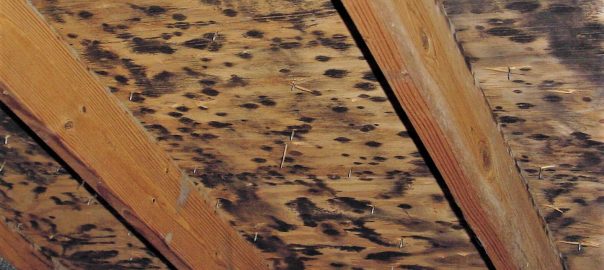Common Causes of Mold in the Attic

Most people assume that mold only occurs in the bathroom or basement until they head into the attic only to gasp at the state of mold in the space. Mold, especially if extensive is unsightly but this isn’t just an aesthetic issue.
Exposure to spores from the mold when inhaled can cause various health issues including headaches, coughing, respiratory problems, trigger allergic reactions or cause digestive issues among other problems. Health risks aside, it is important to point out that not all mold in the attic is toxic. Apart from the possible health issues (or lack thereof) mold indicates underlying issues that need to be resolved as soon as possible.
Causes of Mold in the Attic
There are many possible reasons why there is mold in your attic. Often it is a combination of reasons. Some common causes of mold in the attic in Canada include;
Leaking Roof
This reason is arguably the most obvious and most common cause of mold. Most roof leaks are minor and don’t permeate to the rest of the house making them hard to spot until you visit the attic. Over time, the damp space begins to grow mold. The remedy for this situation is to repair the roof.
Heating and Cooling Systems in Attic
Many homes today have multiple heating and cooling zones meaning requiring more equipment specifically furnaces and water heaters. The equipment to service these zones often finds its way into the attic. Contractors have mixed feelings with some assenting to this practice while others are adamant that the attic is no place for such equipment. Whatever the case, water heaters and furnaces are an ever-present risk of moisture which is difficult to detect on time in out-of-sight places such as the attic. The solution, in this case, is either to move the equipment or inspect the attic at least twice a year for possible moisture issues.
Poor Attic Insulation
Many homeowners prefer DIY attic insulation installation as the go-to option for increasing energy efficiency. While insulation your attic can significantly lower your energy bills, it can cause more problems than it solves if not done properly. A common mistake is to install new insulation with foil backing over old insulation. This method along with other installation mistakes traps moisture in the attic which comes hand in hand with mold growth. Make sure that you get your insulation professionally installed to avoid this problem.
Improper Venting
Many homes with venting leading into the attic experience mold growth. Common vents include dryer, kitchen, bathroom and plumbing vents. These vents introduce warm, moist air into the attic which is a good way to grow mold. The only solution here may be to re-route the venting system outdoors.
Poor Attic Ventilation
Finally, if you’re attic is too hot during winter it will encourage mold to grow. Ideally, the attic temperature should be within 15 degrees of the outdoor temperature. Many people also assume that sealing attic vents during winter lowers the heat loss. This rationale is erroneous since you trap warm, moist air in the attic which is an ideal environment for mold growth.
An easy way to tell if your attic is under ventilated is to look at your roof from the outside after snow. If there are patches on the roof with no snow then there are areas of the attic that are too warm. The snow should be evenly spread on the roof.
What to Do About Mold in the Attic
The best way to deal with mold in the attic is to hire a professional attic insulation removal service in Toronto. Cleaning the mold, even if it is not toxic, is not a good enough solution. You need to get to the root cause of the problem and fix it appropriately otherwise the problem recurs indefinitely. A professional is able to identify the root cause of the problem and apply the proper remediation to solve the problem permanently. The expert will also identify and clean the mold safely and thoroughly in case of toxic spores.